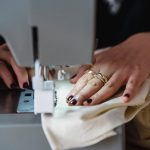Did you know that preventing clothes from bleeding color goes beyond just separating darks from lights? There are simple yet effective steps you can take to keep your favorite garments looking vibrant wash after wash.
By implementing a few key strategies and being mindful of your laundry routine, you can guarantee that your clothes maintain their color integrity for longer.
Let's explore some practical tips to help you achieve color-fast laundry results and preserve the brightness of your wardrobe staples.
Table of Contents
Key Takeaways
- Separate dark and bright colored clothes during washing to prevent color bleeding.
- Use color-protecting detergents and cold water to preserve garment colors.
- Opt for synthetic fibers like polyester to minimize dye transfer between clothes.
- Implement dye fixatives and color-catching sheets to maintain vibrant hues in garments.
Understanding Color Bleeding in Clothes
Color bleeding in clothes often occurs due to ineffective dyeing techniques, resulting in unstable dyes that can lead to color transfer during washing. When manufacturers use overdyeing methods to achieve brighter colors, the excess dye may not properly adhere to the fabric, causing bleeding issues.
Dark and bright colors like red and orange are more prone to bleeding, especially when exposed to water or friction. To prevent color bleeding, choosing pivotal fabrics and implementing proper washing techniques is critical. Red-colored clothes, in particular, require extra care during washing to maintain their vibrancy and prevent bleeding.
Washing new colored items separately, using cold water, and opting for synthetic fibers like polyester can help reduce dye transfer and preserve the integrity of the colors. Understanding the dyeing process and fabric composition is essential in avoiding color bleeding and ensuring your clothes retain their vibrant hues wash after wash.
Importance of Sorting Clothes Properly
Before starting a laundry cycle, sorting clothes properly is essential to guarantee color bleeding between garments. To assure the longevity and vibrancy of your clothes, here are three key steps to follow:
- Sort by Color and Intensity: Group dark, bright, and new items separately to guarantee color transfer and bleeding. Mixing colors like red and white can lead to unwanted dye transfer if not sorted correctly.
- Consider Fabric Type: Sort clothes by fabric type to avoid potential dye transfer during washing. Different fabrics may react differently to detergents and water temperatures, impacting the risk of color bleeding.
- Maintain Vibrant Colors: Establish a consistent sorting routine to maintain the vibrancy of your colored clothes. Properly sorted loads reduce the chances of color bleeding, guaranteeing your garments stay bright and beautiful for longer periods.
Choosing the Right Laundry Detergent
When selecting a laundry detergent to prevent color bleeding in clothes, it's important to choose a product specifically labeled as 'color-safe' or 'color-protect'. These detergents are formulated to maintain the vibrancy of fabrics and prevent colors from running during the washing process.
By opting for a color-safe detergent, you can guarantee that your clothes retain their original hues and prevent dye stability issues that lead to color bleeding. It's essential to avoid detergents containing harsh chemicals or bleach, as these can strip away colors and cause bleeding.
Look for products that are gentle on fabrics and designed to lock in colors, providing effective color protection. Always read product labels carefully to confirm that the detergent is suitable for maintaining the color integrity of your garments. Choosing the right laundry detergent is a fundamental step in fabric care and preserving the quality of your clothes using proper laundry techniques.
Using Cold Water for Washing
I've found that washing clothes in cold water is a game-changer when it comes to preventing color bleeding.
Not only does it help preserve the vibrancy of my garments, but it also reduces the risk of dye transfer between items.
Cold Water Benefits
Using cold water for washing clothes offers multiple benefits, including color preservation and eco-friendliness. Cold water traps dye inside fibers, preventing color bleeding and reducing transfer between garments. This method is ideal for vibrant colors prone to bleeding and is gentle on delicate fabrics. Additionally, washing with cold water saves energy compared to hot water cycles. Embracing cold water washing is a recommended practice for maintaining the longevity and vibrancy of colored clothing items.
Washing Machine Settings
Switching to the appropriate washing machine settings, especially utilizing cold water for washing, is key to effectively preventing color bleeding in clothes. Cold water washing helps trap dye inside fabrics, reducing the risk of color bleeding and preventing colors from running and fading. It is effective in preserving the vibrancy of colored clothes by minimizing dye transfer. Lower water temperatures like cold water are essential on fabrics, maintaining color integrity and preventing clothes from bleeding color. Using the cold water setting on the washing machine is a vital step in ensuring your garments retain their vibrant colors while also safeguarding their fabric integrity.
| Washing Machine Settings | Benefits |
|---|---|
| Cold Water | Prevents color bleeding |
| Reduces dye transfer | |
| Preserves fabric integrity | |
| Maintains vibrant colors |
Color-Protecting Detergents
To maintain the vibrancy of your colored clothes and prevent color bleeding, consider incorporating color-protecting detergents when washing with cold water.
- Color-protecting detergents are specially formulated to lock in colors and prevent bleeding by trapping dye molecules.
- Cold water washing with these detergents helps keep dye molecules intact, preventing color bleeding and maintaining vibrant colors.
- By minimizing color bleeding, color-protecting detergents and cold water washing can extend the life of your colored garments.
Using color-protecting detergents and cold water is essential to preserving the integrity of your colored clothes. These products work to prevent dye transfer and fading, ensuring that your garments retain their original hues and look fresh for longer.
Incorporating Vinegar in Laundry Routine
I find that adding vinegar to my laundry routine greatly helps in preserving the original colors of my clothes and prevents color bleeding issues. Vinegar acts as a natural dye fixative, sealing colors in fabrics to prevent bleeding during washing. Its acetic acid content helps set dyes in clothes, reducing the risk of color transfer onto other garments. Adding vinegar to the final rinse cycle can aid in preserving the vibrancy and integrity of colored clothing. Additionally, vinegar can also act as a fabric softener, minimizing friction and color leaching between garments.
| Benefits of Vinegar in Laundry Routine |
|---|
| Acts as a natural dye fixative |
| Seals colors in fabrics to prevent bleeding |
| Helps set dyes in clothes, reducing color transfer |
| Preserves vibrancy and integrity of colored clothing |
| Acts as a fabric softener, minimizing color leaching |
Benefits of Color-Catcher Sheets
Color-catcher sheets offer great color protection benefits by trapping loose dyes and preventing color transfer during the wash.
They're extremely easy to use and can save time by allowing you to wash colored items together without worrying about bleeding.
Color Protection Benefits
Trapping loose dyes in the laundry water, color-catcher sheets provide essential benefits in preventing color bleeding onto other clothes. Utilizing these sheets offers a range of advantages for maintaining the vibrancy of your garments:
- Prevent Color Bleeding: Color-catcher sheets effectively trap excess dye, preventing it from seeping into other fabrics.
- Maintain Vibrant Colors: By absorbing and locking in excess dyes, these sheets help keep your clothes' colors looking fresh and bright.
- Mix Different Colored Garments: With color-catcher sheets, you can confidently wash a variety of colored items together without the risk of colors bleeding onto each other.
Incorporating color-catcher sheets into your laundry routine can safeguard your clothes and make sure they retain their original hues.
Prevents Color Transfer
Regularly incorporating color-catcher sheets into your laundry routine can effectively prevent color transfer and maintain the vibrancy of your garments.
These sheets, placed in the washing machine, work by trapping loose dye particles during the laundry process. By preventing color bleeding and transfer, they help preserve the integrity of vibrant colored clothes.
Color-catcher sheets are specially designed to absorb and lock in stray dyes, ensuring that your garments retain their original hues. This simple addition to your laundry routine not only saves time and effort by allowing you to wash mixed-color loads together but also serves as a cost-effective solution for keeping your clothes looking fresh and bright.
Prioritizing the use of color-catcher sheets is key to maintaining the vibrancy and longevity of your favorite garments.
Easy to Use
Using color-catcher sheets in your laundry routine is a hassle-free way to prevent color bleeding and maintain the vibrancy of your clothes. When washing clothes in hot water, these sheets efficiently trap loose dyes, preventing color transfer onto other garments.
The benefits of color-catcher sheets include:
- Effortless Protection: Simply toss a sheet into the washing machine to safeguard your clothes.
- Versatile Use: Suitable for various fabrics and all washing machines, making them a convenient laundry essential.
- Vibrant Clothes: By capturing loose dyes, these sheets help assure your colored clothes stay bright and fresh wash after wash.
Incorporating color-catcher sheets into your laundry routine is an easy and effective way to protect your garments and preserve their colors.
Turn Garments Inside Out Before Washing
To protect your clothes from color bleeding, always turn garments inside out before tossing them in the washer. This simple step can greatly reduce friction on the outer surface of your garments, which helps minimize color fading. Turning clothes inside out shields the outer layer of the fabric, where most dyes and prints are located, from direct contact with other items in the laundry. By doing so, you can prevent excessive rubbing and abrasion during the wash cycle, ultimately preserving the intensity of the colors in your garments.
This practice is particularly beneficial for dark or vibrant-colored clothing items that are more susceptible to color bleeding and fading. By incorporating the habit of turning garments inside out before washing, you can maintain the vibrancy and longevity of your colored clothes over time. Remember, the small effort of flipping your clothes inside out can go a long way in keeping them looking fresh and colorful wash after wash.
Testing for Colorfastness
I'm going to talk about how to test for colorfastness using water and a cloth, a rubbing test, and a drying method. By performing these tests, you can determine if a fabric is colorfast and won't bleed during washing.
This step is important to prevent color transfer and potential damage to your clothes.
Water and Cloth
When checking for colorfastness in fabrics, a simple water test can help determine if the colors will bleed during washing. Here's how to use water to protect your clothes:
- Wet a small area of the fabric with cold water.
- Press a white cloth against the wet area and check for color transfer to confirm consistent colorfastness and minimize bleeding and fading.
- Repeat the test in different spots on the fabric to validate consistent colorfastness and reduce friction during washing.
Using cold water and this methodical approach will help you remove color bleeding, stop clothing from releasing dye, and ultimately safeguard your garments from unwanted color mishaps.
Rubbing Test
Engage in the rubbing test by briskly rubbing a white cloth against the colored fabric to assess color transfer, indicating potential bleeding during washing. This test helps determine the colorfastness of the fabric and predicts if the garment may bleed color.
If the white cloth picks up color, it suggests that the fabric is likely to bleed during washing. Colorfast fabrics won't transfer color during this test, showing they're less prone to bleeding.
Conducting this test before washing can guide you on proper washing methods to prevent color bleeding. By maintaining colorfastness, you can safeguard the vibrancy of your colored clothes and make sure they remain bright and fresh after each wash.
Drying Method
To guarantee your colored clothes don't bleed during washing, testing for colorfastness through a drying method is essential. Here's how to prevent color bleeding and fading:
- Test for colorfastness by placing a damp white cloth on a hidden area of the garment and pressing with a hot iron to check for color transfer.
- If no color transfers to the white cloth, it's safe to proceed with air drying the garment to prevent color bleeding.
- Avoid using high heat when drying colored clothes to maintain their vibrancy and prevent dye from transferring onto other items.
Following proper drying methods based on colorfastness testing can help preserve the original appearance of your clothes.
Implementing Dye Fixatives
I often rely on dye fixatives to effectively lock in colors and prevent bleeding in my clothes. Dye fixatives are essential products designed to set dyes in fabric and prevent color bleeding during washing. They work by chemically binding the dye to the fibers of the fabric, making it less likely to leach out. By following the manufacturer's instructions carefully when using dye fixatives, I guarantee the best results. These fixatives can be used for both new and old garments to help maintain the vibrancy of colored clothes and extend their lifespan. Here is a table highlighting the benefits of incorporating dye fixatives into your laundry routine:
| Benefits of Dye Fixatives | |
|---|---|
| Prevents Color Bleeding | Locks in Colors |
| Extends Clothes Lifespan | Maintains Vibrancy |
| Works for New and Old Garments | Easy to Use |
Incorporating dye fixatives into your laundry routine is a key step in ensuring your colored clothes remain vibrant and bleed-free.
Avoiding Overloading the Washing Machine
By allowing clothes ample room to move freely in the washer, you can prevent color bleeding caused by friction between garments. Overloading the washing machine can lead to dyes transferring between clothes, resulting in colors bleeding onto other items. To avoid this, follow these key steps:
- Provide Sufficient Space: Make sure there's enough room in the washer for clothes to swish around freely during the wash cycle. This helps prevent friction between garments that can cause color bleeding.
- Avoid Packing Clothes Firmly: Don't overload the washing machine by cramming too many clothes into one load. Giving each garment enough space reduces the risk of colors bleeding onto other pieces.
- Maintain Proper Water and Detergent Distribution: By not overloading the washer, you allow water and detergent to distribute evenly, enhancing the cleaning process while safeguarding the integrity and vibrancy of your colored clothes. Proper loading ensures effective cleaning and helps maintain the original colors of your garments.
Long-Term Strategies for Maintaining Color Vibrancy
Maintaining color vibrancy over time involves incorporating long-term strategies like utilizing color protection techniques and implementing proper care practices to preserve the integrity of your garments.
To prevent color bleeding, consider rinsing colored clothes in cold water with a splash of white vinegar before washing. This helps establish the dyes and minimize color transfer. Additionally, separate less stable colors from the rest and wash them individually to prevent color rubs.
When laundering, opt for gentle cycles and avoid overloading the washer to maintain the vibrancy of your garments. Incorporating color-catcher sheets in your wash can trap loose dyes and prevent them from staining other clothes.
To further safeguard colors, air-dry your garments and rotate them in your wardrobe regularly to prevent fading. By following these strategies consistently, you can make sure that your clothes retain their vivid hues and look fresh for longer periods.
Frequently Asked Questions
Does Vinegar Stop Color Bleeding?
Yes, vinegar stops color bleeding. It seals in dye, preventing transfer onto other clothes. The acetic acid acts as a fixative to set colors and reduce bleeding. Adding vinegar in the final rinse cycle locks in colors, maintaining vibrancy.
Does Salt Stop Color Bleeding?
Salt alone does not effectively stop color bleeding in clothes. It lacks the necessary properties to seal in dyes. For better results, use vinegar or commercial dye fixatives designed for this purpose. These options are more effective.
How Do You Wash Clothes That Run Color?
To wash clothes that run color, I separate darks from lights, turn them inside out, and use cold water. I also add a color-catching sheet and avoid overloading the washer. These steps prevent color bleeding and keep my clothes vibrant.
How Do You Set Fabric Dye?
To set fabric dye, I add 1 cup of vinegar to cold water, then soak the garment for 30 minutes. After rinsing in cold water, I air dry away from sunlight. If needed, repeat the vinegar setting process.
- Tetron Fabric for Marine Applications: Durability and Use Cases - June 18, 2025
- Tetron Fabric for Outdoor Furniture: Weather Resistance and Care - June 18, 2025
- Tetron Fabric for Wall Coverings: Style and Application Tips - June 18, 2025







